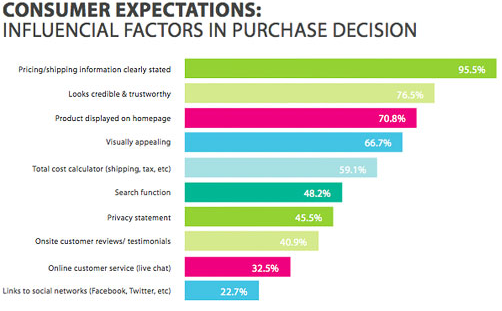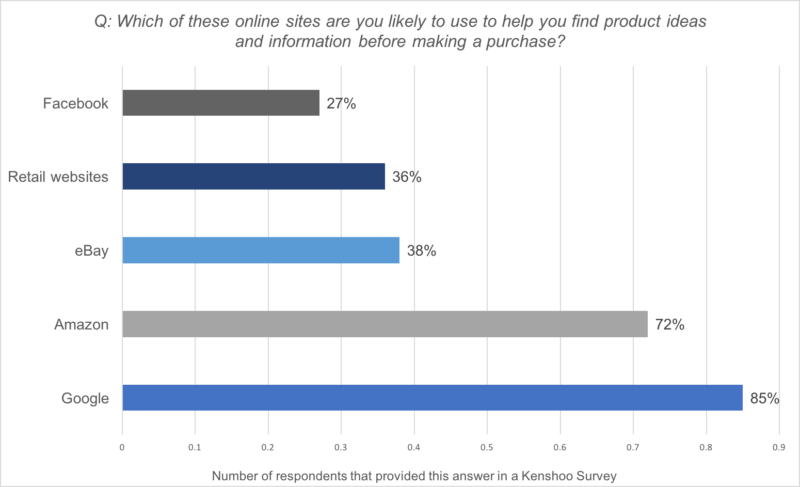
We often are sought out for eCommerce advice from small to medium-sized eCommerce businesses. Many merchants are overwhelmed with workloads and creative ideas they seem to never get to. Many ask us where their time and efforts should be best spent. There’s not enough time in the day (or budget hours) for these types of businesses to do it all.
So, what matters most for success and growth? Where should these businesses start? We advise that an effective strategy for small to medium-sized merchants is comprised of three key eCommerce fundamentals, which are mastering customer experience, channel visibility, and focused marketing efforts.
Customer Experience
Creating a seamless shopping experience for your customers should always be at the top of your priority list. If there are hang-ups at any point in the customer’s path to purchase experience, such as poor search results or limited shipping options, money is being left on the table. Customer expectations continue to grow at a rapid rate due to eCommerce giants providing top-notch eCommerce experiences.
Customer Experience and The Amazon Effect
Amazon is changing the eCommerce landscape while continuing to increase the expectations of the customer.
An article from Forbes on this topic reinforces this statement, “Merely meeting expectations is a myth. No one just ‘meets expectations’ anymore. You either exceed expectations, or you fall short.” It’s no secret that Amazon has always put a strong focus on what the customer wants and will do what it takes to exceed those expectations.
Jeff Bezos, CEO of Amazon says, “We’re not competitor obsessed, we’re customer obsessed. We start with the customer and we work backward…We’ve had three big ideas at Amazon that we’ve stuck with for 18 years, and they’re the reason we’re successful: Put the customer first. Invent. And be patient.”
In order to be competitive in the eCommerce space, merchants of all size need to shift their focus on the customer experience while exceeding expectations.
Customer Experience and the Path-to-Purchase
The full customer experience, or the path-to-purchase, from search to shipment needs to rival that of the big players. As customers spend more time shopping online, they will continue to expect more and more from merchants. The graph below from GetElastic shows some notable trends about customer expectations:

Unsurprisingly, 95% of customers say that shipping plays a significant role in conversions. Shipping can add several dollars to a purchase. When customers are hit with unexpected shipping costs, it can send them looking at competitors.
Trust is also a key component with 76% of customers saying that trustworthiness plays a key role in their purchases. There is some uncertainty when it comes to online shopping. We live in a day and age when customers worry about the information being taken. If a website seems outdated or is lacking trust-building measures such as reviews or familiar payment options, it can send customers away.
Products displayed on the homepage comes in as the third most influential for making an online purchase with 70% noting its importance. People shop online quickly. When a customer lands on your homepage, they want to see what they’re looking for immediately. That’s why excellent site search functionality has become increasingly important.
Creating a seamless customer experience is one of the most basic fundamentals of eCommerce. Without a solid path-to-purchase focus in place, merchants are losing customers and money.
Customer Experience and The Right eCommerce Platform
A key part of your customer experience is, or will be, choosing the right eCommerce platform to support your business needs. Merchants must maximize the benefit of features vs cost. Your eCommerce platform and what you can and can’t do with it will have an impact on your online store.
Smaller merchants typically lack the budget to overspend on technology or hosting. Therefore, they must choose wisely between open source flexibility and features (Magento Open Source, WooCommerce) vs. lower cost and efficient SAAS (BigCommerce, Shopify).
Merchants must decide when it comes to features and performance on what will help fuel growth and conversions. For the right size merchant, features and performance may be best served by a powerful, scalable, and flexible platform like Magento. For smaller merchants, power and scalability may not be as important as price and ease of management. And a platform like Shopify would be the better choice.
Channel Visibility
Merchants must be proactive about new ways to get in front of customers. It’s no longer good enough to rely on being found organically via a Google search or even from a PPC ad. Data from 2017 shows that 72% of shoppers start their initial search on Amazon – not Google. What does this mean for small to medium-sized merchants? It’s now time to think of Amazon more like how we used to think of Google. And that may mean selling products on Amazon even though margins will suffer. And if a merchant can maintain control of the shipping functionality, the remarketing opportunities are many.

Customers are also utilizing social media platforms for research also. As shown in the graph above, 27% of shoppers noted that they would use Facebook as a tool for their buying decision. And merchants are experimenting with extending their brand by offering shopping options on Instagram and Pinterest.
All this tells us that merchants need more than just a well-run website to be successful. Merchants must consider 3rd party marketplaces as a way to get more views and increase sales. Merchants can sell through top marketplaces like Amazon, Walmart, eBay, and Rakuten.
While there has been a shift to Amazon for researching products, Google and Bing are still key players. It could also benefit merchants to consider other key social and shopping engines like Facebook, Instagram, and Ebates.
Focused Digital Marketing Efforts
Merchants need to ensure their digital marketing dollars are focused on the right channels and efforts that will convert. Typically, small to medium-sized businesses lack the financial capabilities to invest in all forms of digital marketing. Knowing what efforts work best for your business is key to success.
Learning what works, and what won’t, will be different for each business. But, it’s key to focus and spend wisely between PPC, SEO, eMail and social. Not all marketing channels will provide each business with equal ROI. PPC can be a quick fix, to drive immediate traffic, but it can also be too costly, long-term for smaller merchants. SEO can be a powerful tool if done well, but SEO success takes patience, sometimes a difficult “ask” given the costs involved.
The standard approach in eCommerce used to be some PPC mixed with SEO followed up with eMail. While that method still works for some, for others based on industry or available marketing budget, it could make perfect sense for a merchant such as a fashion retailer to surgically increase ROI via social media channels such as Facebook and/or Instagram.
And speaking of email, merchants who aren’t utilizing their customer email database to engage, build their brand and yes, provide offers are likely missing out on the lowest hanging marketing-to-revenue fruit of all.
Choose a partner to help you succeed
In order to survive and grow in today’s eCommerce ecosystem, small to medium-sized merchants must be savvy in the way they prioritize investment in the customer experience, channel visibility, and digital marketing.
It’s also important to note that without an in-house team, many of these efforts will be too much to handle, both from a complexity and bandwidth perspective. Choosing an eCommerce partner experienced in these key areas can have a huge benefit on business. InteractOne has the experience and expertise to help merchants of all sizes understand where best to prioritize their efforts. Notably, a great partner will have the resources to help merchants execute these priorities.
Contact us to learn more about optimizing path-to-purchase journey for your customers or more information on the right digital marketing efforts for your business.